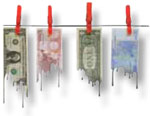 “The Phoenicians invented money, but why so little of it?” is how the Austrian writer Johann Nestroy phrased the question. The consequences of that particular innovation are feared even today by politicians and whoever is responsible for the currency. Debt and nothing but debt, and no simple solutions for dealing with the lack of money once and for all. Blame is laid on the central banks, the second most significant invention after the discovery of fire. But these days, politicians have been cutting them down several notches, with a budget management best termed “generous”.
“The Phoenicians invented money, but why so little of it?” is how the Austrian writer Johann Nestroy phrased the question. The consequences of that particular innovation are feared even today by politicians and whoever is responsible for the currency. Debt and nothing but debt, and no simple solutions for dealing with the lack of money once and for all. Blame is laid on the central banks, the second most significant invention after the discovery of fire. But these days, politicians have been cutting them down several notches, with a budget management best termed “generous”.
The shekel is an invention dating back to Babylonian and Phoenician times. 180 grains weighed 8 grams. 8 grams of silver were equal to one shekel. 3.000 years ago, you could buy 360 fish for that. In Israel today, one shekel will get you a glass of water – tap water. A drastic lack of money and high prices recently drove hundreds of thousands onto the streets to demonstrate. The Governor of the Bank of Israel, the American Stanley Fischer, will hardly be able to help the Israeli government.
Today, the global star among currencies is the US dollar. It is the world’s reserve currency, but it has seen some highs and lows in its time. Once, when it had plummeted to unknown depths, Secretary of the Treasury, John Connally noted drily, “The dollar is our currency, but your problem.” He meant the Europeans when he said that. These days, with the government financing crisis looming over our heads, the US seem to be telling us: “The euro is your currency, but not our problem.” This is the basis for the American position on potential support from the IMF for the countries of the euro area.
The precursor of the euro was the French silver coin “ecu”, which bore the image of Louis XIV and was in use in the 18th century. But in truth, it is the deutschmark that is behind the €, the only currency in history to be given up because it was doing too well. Those thinking along historic lines will perhaps see the deutschmarkization of the euro we are witnessing, for example as a result of the resolutions passed in Brussels in early December of 2011, as the late revenge taken by the supporters of the deutschmark.
It is an irony of history that in the eyes of quite a number of Israelis, their currency, the New Israeli Shekel (NIS), is the most stable – and they are certainly right where the exchange rate is concerned. This will most likely be due to the fact that the shekel simply is too small a currency to play any particular role on the international finance markets. In that, it contrasts sharply with the Chinese Yuan, the currency of the largest nation on earth and biggest global exporter. But in this case the exchange rate is determined by the government in Beijing – much to the disapproval of the Americans. But that’s another story.
